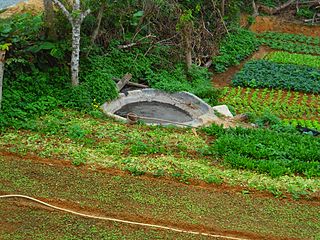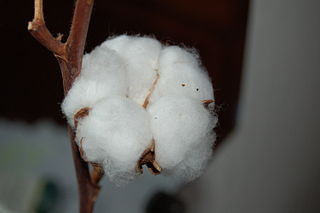This article needs additional citations for verification .(January 2016) |
Fish emulsion is a fertilizer emulsion that is produced from the fluid remains of fish processed for fish oil and fish meal industrially.
This article needs additional citations for verification .(January 2016) |
Fish emulsion is a fertilizer emulsion that is produced from the fluid remains of fish processed for fish oil and fish meal industrially.
The process of creating fish emulsion begins with whole fish, or with carcass products of fish, such as bones, scales, and skin, which are left after a fish has been processed. The fish and carcass products are then ground into a slurry. After the oils and fish meal are removed from the slurry, the slurry is officially a fish emulsion. Most emulsions are then strained to remove any remaining solids, and sulfuric acid is often added to increase the acidity and prevent the growth of microbes. [1]
Since fish emulsion is naturally derived, it is considered an organic fertilizer appropriate for use in organic horticulture. In addition to having a typical N-P-K analysis of 5-2-2, fish emulsion adds micronutrients. [2]
Fish emulsion, applied as a liquid fertilizer, is also used when growing roses to enhance the bloom color of the flowers. [3]

Compost is a mixture of ingredients used as plant fertilizer and to improve soil's physical, chemical, and biological properties. It is commonly prepared by decomposing plant and food waste, recycling organic materials, and manure. The resulting mixture is rich in plant nutrients and beneficial organisms, such as bacteria, protozoa, nematodes, and fungi. Compost improves soil fertility in gardens, landscaping, horticulture, urban agriculture, and organic farming, reducing dependency on commercial chemical fertilizers. The benefits of compost include providing nutrients to crops as fertilizer, acting as a soil conditioner, increasing the humus or humic acid contents of the soil, and introducing beneficial microbes that help to suppress pathogens in the soil and reduce soil-borne diseases.

A fertilizer or fertiliser is any material of natural or synthetic origin that is applied to soil or to plant tissues to supply plant nutrients. Fertilizers may be distinct from liming materials or other non-nutrient soil amendments. Many sources of fertilizer exist, both natural and industrially produced. For most modern agricultural practices, fertilization focuses on three main macro nutrients: nitrogen (N), phosphorus (P), and potassium (K) with occasional addition of supplements like rock flour for micronutrients. Farmers apply these fertilizers in a variety of ways: through dry or pelletized or liquid application processes, using large agricultural equipment or hand-tool methods.

Styrene-butadiene or styrene-butadiene rubber (SBR) describe families of synthetic rubbers derived from styrene and butadiene. These materials have good abrasion resistance and good aging stability when protected by additives. In 2012, more than 5.4 million tonnes of SBR were processed worldwide. About 50% of car tires are made from various types of SBR. The styrene/butadiene ratio influences the properties of the polymer: with high styrene content, the rubbers are harder and less rubbery. SBR is not to be confused with the thermoplastic elastomer, styrene-butadiene block copolymer, although being derived from the same monomers.
Rendering is a process that converts waste animal tissue into stable, usable materials. Rendering can refer to any processing of animal products into more useful materials, or, more narrowly, to the rendering of whole animal fatty tissue into purified fats like lard or tallow. Rendering can be carried out on an industrial, farm, or kitchen scale. It can also be applied to non-animal products that are rendered down to pulp. The rendering process simultaneously dries the material and separates the fat from the bone and protein, yielding a fat commodity and a protein meal.

Biosolids are solid organic matter recovered from a sewage treatment process and used as fertilizer. In the past, it was common for farmers to use animal manure to improve their soil fertility. In the 1920s, the farming community began also to use sewage sludge from local wastewater treatment plants. Scientific research over many years has confirmed that these biosolids contain similar nutrients to those in animal manures. Biosolids that are used as fertilizer in farming are usually treated to help to prevent disease-causing pathogens from spreading to the public. Some sewage sludge can not qualify as biosolids due to persistent, bioaccumulative and toxic chemicals, radionuclides, and heavy metals at levels sufficient to contaminate soil and water when applied to land.

Agricultural wastewater treatment is a farm management agenda for controlling pollution from confined animal operations and from surface runoff that may be contaminated by chemicals in fertilizer, pesticides, animal slurry, crop residues or irrigation water. Agricultural wastewater treatment is required for continuous confined animal operations like milk and egg production. It may be performed in plants using mechanized treatment units similar to those used for industrial wastewater. Where land is available for ponds, settling basins and facultative lagoons may have lower operational costs for seasonal use conditions from breeding or harvest cycles. Animal slurries are usually treated by containment in anaerobic lagoons before disposal by spray or trickle application to grassland. Constructed wetlands are sometimes used to facilitate treatment of animal wastes.

Organic fertilizers are fertilizers that are naturally produced. Fertilizers are materials that can be added to soil or plants, in order to provide nutrients and sustain growth. Typical organic fertilizers include all animal waste including meat processing waste, manure, slurry, and guano; plus plant based fertilizers such as compost; and biosolids. Inorganic "organic fertilizers" include minerals and ash. The organic-mess refers to the Principles of Organic Agriculture, which determines whether a fertilizer can be used for commercial organic agriculture, not whether the fertilizer consists of organic compounds.
Bone meal is a mixture of finely and coarsely ground animal bones and slaughter-house waste products. It is used as a dietary supplement to supply calcium and phosphorus to monogastric livestock in the form of hydroxyapatite. As a slow-release organic fertilizer, it supplies phosphorus, calcium, and a small amount of nitrogen to plants.
Blood meal is a dry, inert powder made from blood, used as a high-nitrogen organic fertilizer and a high protein animal feed. N = 13.25%, P = 1.0%, K = 0.6%. It is one of the highest non-synthetic sources of nitrogen. It usually comes from cattle or hogs as a slaughterhouse by-product.

Cottonseed is the seed of the cotton plant.

Fish meal is a commercial product made from whole wild-caught fish, bycatch, and fish by-products to feed farm animals, e.g., pigs, poultry, and farmed fish. Because it is calorically dense and cheap to produce, fishmeal has played a critical role in the growth of factory farms and the number of farm animals it is possible to breed and feed.
Chicken meal is the dry rendered product from a combination of clean chicken flesh and skin with or without accompanying bone, derived from whole carcasses of chicken, exclusive of feathers, heads, feet and entrails. Meal here is used in the sense of "an ingredient which has been ground or otherwise reduced in particle size." It is mainly used in pet foods.

The term fish processing refers to the processes associated with fish and fish products between the time fish are caught or harvested, and the time the final product is delivered to the customer. Although the term refers specifically to fish, in practice it is extended to cover any aquatic organisms harvested for commercial purposes, whether caught in wild fisheries or harvested from aquaculture or fish farming.
Feather meal is a byproduct of processing poultry; it is made from poultry feathers by partially grinding them under elevated heat and pressure, and then grinding and drying. Although total nitrogen levels are fairly high, the bioavailability of this nitrogen may be low. Feather meal is used in formulated animal feed and in organic fertilizer.

Fish and fish products are consumed as food all over the world. With other seafoods, they provides the world's prime source of high-quality protein; 14–16 percent of the animal protein consumed worldwide. Over one billion people rely on fish as their primary source of animal protein.
Fish hydrolysate, in its simplest form, is ground up fish transformed into a liquid phase, where the cleavage of molecular bonds occurs through various biological processes. Raw material choice; either whole fish or by-products, depends on the commercial sources of the fish. In some cases, the fillet portions are removed for human consumption, the remaining fish body is put into water and ground up. Some fish hydrolysate is ground more finely than others so more bone material is able to remain suspended. Enzymes may also be used to dissolve bones, scale and meat. If the larger chunks of bone and scales are screened out, calcium or mineral content may be lacking in the finished product form. If purchasing fish hydrolysate for agricultural applications, one should look at the label carefully for the concentration of mineral elements in the liquid. Some fish hydrolysates have been made into a dried product, increasing the potential for inclusion as an ingredient in other food or feed products. The oil is separated out in this process, which means the Omega 3 fatty acid would remain with the oil and not the hydrolysate.
Deinking is the industrial process of removing printing ink from paperfibers of recycled paper to make deinked pulp.

Meat and bone meal (MBM) is a product of the rendering industry. It is typically about 48–52% protein, 33–35% ash, 8–12% fat, and 4–7% water. It is primarily used in the formulation of animal feed to improve the amino acid profile of the feed. Feeding of MBM to cattle is thought to have been responsible for the spread of BSE ; therefore, in most parts of the world, MBM is no longer allowed in feed for ruminant animals. However, it is still used to feed monogastric animals.

Manure is organic matter that is used as organic fertilizer in agriculture. Most manure consists of animal feces; other sources include compost and green manure. Manures contribute to the fertility of soil by adding organic matter and nutrients, such as nitrogen, that are utilised by bacteria, fungi and other organisms in the soil. Higher organisms then feed on the fungi and bacteria in a chain of life that comprises the soil food web.